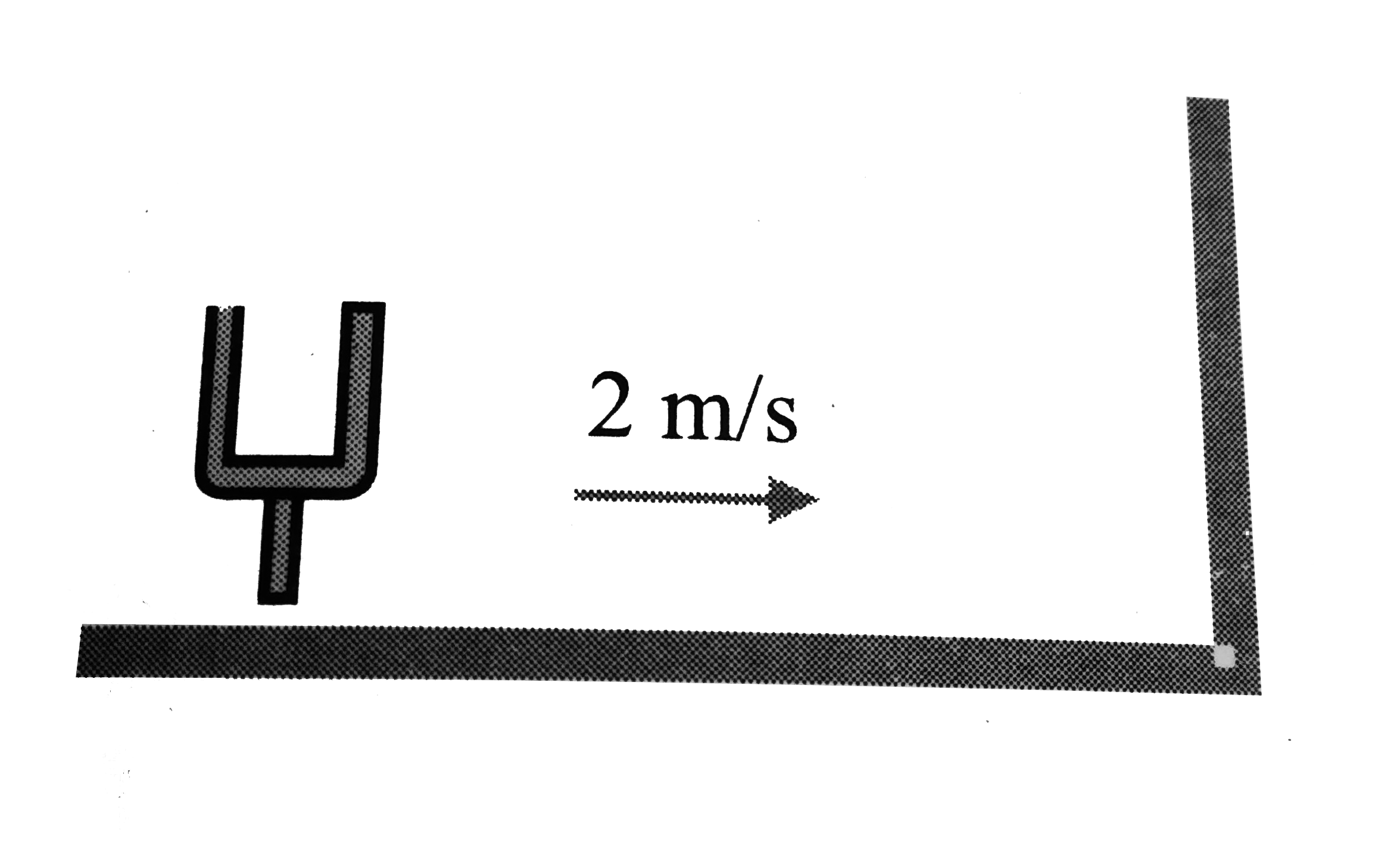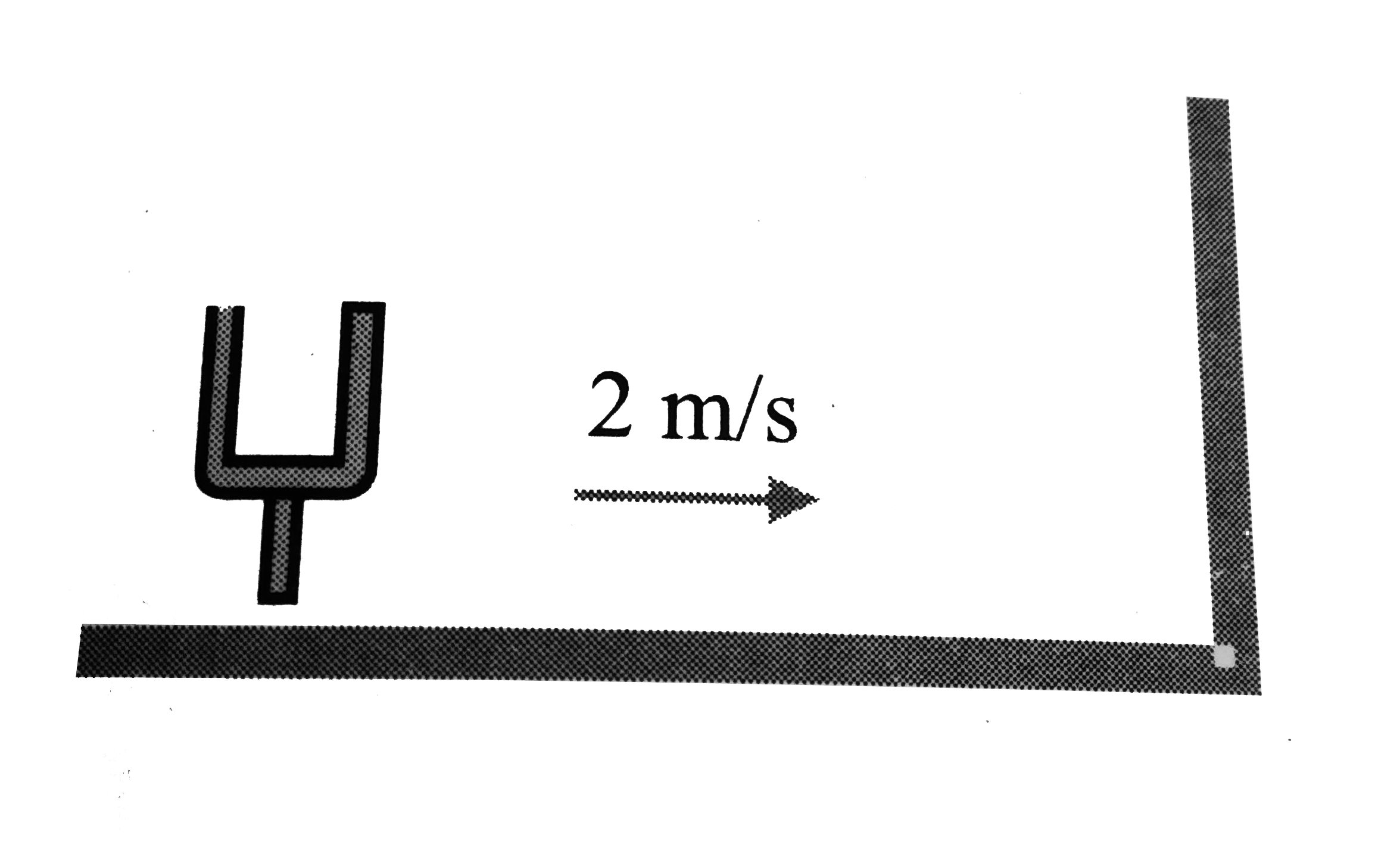A person with vibrating tuning fork of frequency 338 Hz is moving towards a vertical wall with speed of 2ms−1 Velocity of sound in air is 340ms−1 The number of beats heard per second is
2
4
6
8
The correct Answer is:B
To solve the problem, we will follow these steps:
Step 1: Identify the given values
- Frequency of the tuning fork (f) = 338 Hz
- Speed of the person (vs) = 2 m/s
- Velocity of sound in air (v) = 340 m/s
Step 2: Calculate the apparent frequency (f') heard by the wall
When the source of sound (the person with the tuning fork) is moving towards a stationary observer (the wall), the apparent frequency can be calculated using the formula:
f′=vv−vs⋅f
Substituting the values:
f′=340340−2⋅338
f′=340338⋅338
f′=340 Hz
So, the frequency heard by the wall is 340 Hz.
Step 3: Calculate the apparent frequency (f'') heard by the person after reflection
Now, the wall acts as a source of sound, and the person is moving towards it. The new apparent frequency can be calculated using:
f′′=v+vov−vs⋅f′
Here, vo (the velocity of the observer, which is the person) is also 2 m/s. Substituting the values:
f′′=340+2340−0⋅340
f′′=342340⋅340
f′′=342 Hz
Step 4: Calculate the beat frequency
The beat frequency is the difference between the two frequencies:
Beat frequency=f′′−f′
Substituting the values:
Beat frequency=342−340=2 Hz
Step 5: Conclusion
The number of beats heard per second is 2 Hz.
---
- Frequency of the tuning fork (f) = 338 Hz
- Speed of the person (vs) = 2 m/s
- Velocity of sound in air (v) = 340 m/s
When the source of sound (the person with the tuning fork) is moving towards a stationary observer (the wall), the apparent frequency can be calculated using the formula:
f′=vv−vs⋅f
Substituting the values:
f′=340340−2⋅338
f′=340338⋅338
f′=340 Hz
So, the frequency heard by the wall is 340 Hz.
Now, the wall acts as a source of sound, and the person is moving towards it. The new apparent frequency can be calculated using:
f′′=v+vov−vs⋅f′
Here, vo (the velocity of the observer, which is the person) is also 2 m/s. Substituting the values:
f′′=340+2340−0⋅340
f′′=342340⋅340
f′′=342 Hz
The beat frequency is the difference between the two frequencies:
Beat frequency=f′′−f′
Substituting the values:
Beat frequency=342−340=2 Hz
The number of beats heard per second is 2 Hz.
Topper's Solved these Questions
- WAVE MOTIONBOOK - AAKASH SERIESCHAPTER - WAVE MOTIONEXERCISE - ADDITIONAL PRACTICE EXERCISE (LEVEL-II(LACTURE SHEET ADVANCED) MORE THAN ONE CORRECT ANSWER TYPE QUESTIONS))
3 Videos
- WAVE MOTIONBOOK - AAKASH SERIESCHAPTER - WAVE MOTIONEXERCISE - ADDITIONAL PRACTICE EXERCISE (LEVEL-II(LACTURE SHEET ADVANCED) MATRIX MATCHING TYPE QUESTIONS))
2 Videos
- WAVE MOTIONBOOK - AAKASH SERIESCHAPTER - WAVE MOTIONEXERCISE - PRACTICE SET (EXERCISE-VI (LEVEL-II(ADVANCED) INTEGER TYPE QUESTIONS))
4 Videos
- UNITS AND MEASUREMENTSBOOK - AAKASH SERIESCHAPTER - UNITS AND MEASUREMENTSEXERCISE - EXERCISE -3
66 Videos
- WAVE MOTION AND SOUNDBOOK - AAKASH SERIESCHAPTER - WAVE MOTION AND SOUNDEXERCISE - PROBLEMS (LEVEL - II)
97 Videos
Similar Questions

As shown if Fig. a vibrating tuning fork of frequency 512 Hz is moving towards the wall with a speed 2ms. Take speed of sound as v=340ms and answer the following questions.
Q. If the listener is at rest and located such that the tuning fork is moving between the listener and the wall, number of beats heard by the listerner per second will be nearly
View Solution
As shown if Fig. a vibrating tuning fork of frequency 512 Hz is moving towards the wall with a speed 2ms. Take speed of sound as v=340ms and answer the following questions.
Q. If the listener, along with the source, is moving towards the wall with the same speed i.e., 2ms, such that the source remains between the listerner and the wall, number of beats heard by the listerner per second will be
View Solution
As shown if Fig. a vibrating tuning fork of frequency 512 Hz is moving towards the wall with a speed 2ms. Take speed of sound as v=340ms and answer the following questions.
Q. If the listener, along with the source, is moving towards the wall with the same speed i.e., 2ms, such that the source remains between the listerner and the wall, number of beats heard by the listerner per second will be
View SolutionA person carrying a whistle emitting continuously a note of 272Hz is runnig towards a reflecting surface with a speed of 18km/h. The speed of sound in air is 345ms−1 The number of beats heard by him is
View SolutionA tuning fork of frequency 256hZ is moving towards a well with a velocity of 5m/s . If the speed of sound is 330m/s , then the number of beats heard per second by a stationary observer lying between tuning fork and the well is
View Solution
As shown if Fig. a vibrating tuning fork of frequency 512 Hz is moving towards the wall with a speed 2ms. Take speed of sound as v=340ms and answer the following questions.
Q. If the listerner along with the source is moving towards the wall with the same speed i.e., 2ms, such that he (listener) remains between the source and the wall, number of beats heard by him will be
View Solution
As shown if Fig. a vibrating tuning fork of frequency 512 Hz is moving towards the wall with a speed 2ms. Take speed of sound as v=340ms and answer the following questions.
Q. Suppose that a listener is located at rest between the tuning fork and the wall. Number of beats heard by the listener per second will be
View Solution
As shown if Fig. a vibrating tuning fork of frequency 512 Hz is moving towards the wall with a speed 2ms. Take speed of sound as v=340ms and answer the following questions.
Q. Suppose that a listener is located at rest between the tuning fork and the wall. Number of beats heard by the listener per second will be
View SolutionThere is a source of sound (a tuning fork) moving towards a reflecting wall will a speed of 30ms−1. The velocity of the sound in air is 330ms−1and the frequency of the tuning fork is 600 Hz. The observer is between the source and the wall and is moving with some velocity V1 towards the wall. The beat frequency heard by the observer is 4 Hz. If the tuning fork is waxed, the frequency beats heard by the observer becomes 3 Hz. If the new frequency of tuning fork is k then k/50 is

View SolutionFind the number of vibrations made by a tuning fork of frequency 480Hz during the time the sound travels a distance 220m. Velocity of sound =330ms−1.
View Solution
